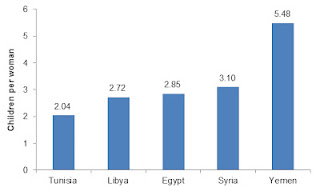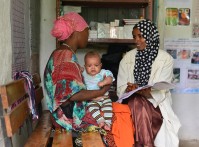-
Yemen: Revisiting Demography After the Arab Spring
April 17, 2012 By Elizabeth Leahy Madsen
Along with other countries where the Arab Spring caught hold, Yemen has been gripped by major upheaval over the past year. Although President Ali Abdullah Saleh finally ceded power in February after his administration’s violent reprisals failed to deter protesters, the country remains at a crossroads. As its political future continues to evolve, the new government must also address a range of deep-seated economic and social challenges. In addition to claiming more than 2,000 lives, the crisis has undermined Yemenis’ livelihoods and even their access to food. A recent World Food Program survey found that more than one-fifth of Yemen’s population is living in conditions of “severe food insecurity” – double the rate measured three years ago – and another fifth is facing moderate difficulty in feeding themselves and their families.
Yemen’s population trajectory is one of the underlying factors shaping its prospects for stability and the success of the movement towards democracy. Two years ago, I wrote a case study about the effect of demographic conditions on the prospects for development in Yemen. Political tumult aside, the country’s demographic picture remains the same, with UN projections showing that Yemen has the second-youngest population in the world after Uganda. “If we had dealt with the population issue seriously, we would have avoided the current problems and crises in Yemen,” Jamela Saleh Al-Raiby, the deputy minister of public health and population, recently commented in the Yemen Times.
The Demographic Challenge Continues
Countries with a very young age structure face higher vulnerability to civil conflict and lower chances of democratic governance. Among the countries where a push for democracy took root during the Arab Spring, Yemen has the youngest age structure. As political demographer Richard Cincotta noted last March, it was more likely than either Egypt or Tunisia to experience ongoing political violence when evaluated in demographic terms. Seventy-five percent of Yemen’s population is younger than 30, compared to 60 percent in Egypt and 52 percent in Tunisia, according to UN data. Driven by a fertility rate of about 5.5 children per woman – nearly twice as high as the regional average – each younger age group is larger than the last. If fertility remains constant, the population would double to 50 million by the early 2030s and triple by 2045. In the more hopeful scenario in which fertility declines toward three children per woman, the population would still double by 2040.
The number of children younger than 15, whose access to education is critical for the country’s development, has grown by two million (25 percent) in just 10 years. Likewise, the number of young people between the ages of 15 and 29, who are completing education, entering the job market, and often hoping to marry, grew from less than five million in 2000 to more than seven million in 2010.
Early marriage, which is a key driver of high fertility rates, is common in Yemen. Half of current reproductive-age women were married before they turned 18, and the government has stalled on attempts to institute a minimum age of marriage. About 28 percent of married women are using contraception and another 24 percent would prefer to avoid pregnancy but are not using contraception, demonstrating a substantial unmet need for family planning.
Unemployment, Poverty, and a Water Crisis
Population trends are closely tied to three other key challenges for Yemen: economic underdevelopment, natural resource shortages, and declining health. Yemen’s economy has not kept pace with the employment needs of its youthful and rapidly growing population. As of 2008, the adult unemployment rate was 15 percent, reflecting the share of working age people who are actively seeking jobs. While the female labor force is small due to traditional gender roles, unemployment is much higher among women (41 percent) than men (12 percent), and twice as many women are illiterate as men. Even among working adults, income is often too low to meet basic living standards, as more than two-fifths of the population lives in poverty.
The oil and gas sector comprises half of the country’s GDP, according to the World Bank, but oil reserves and revenues are declining. Prior to Saleh’s ouster, the government had begun trimming fuel subsidies, which consume 20 to 25 percent of its expenditures. In addition, economic expansion has been hampered by the ubiquitous use of qat, a mild narcotic whose production employs about 15 percent of the workforce but consumes 10 percent of household budgets, 10 percent of land area devoted to agriculture, one third of all ground water extracted, and untold productivity lost due to daily use of the drug.
While both oil and agriculture are under strain, the most critical natural resource for Yemen is arguably water. While Yemen has always been an arid country without rivers or freshwater lakes to draw upon, population growth is one of the primary reasons that water shortages have reached such critical levels. At a Wilson Center seminar on Yemen last year, the founder of the Ministry of Water and the Environment noted that the country’s level of water availability is 14 times below the threshold for water scarcity. With unpredictable rainfall, farmers and families rely on water drawn from slow-regenerating aquifers, consuming it at a much higher rate than the groundwater can be replenished.
Civil Unrest Affects Health and Nutrition
Despite recent increases in the number of health clinics and hospitals, Yemen’s health system remains weak and out of reach for most of the population. The government spends six percent of its budget on health, less than one-third as much as it contributes in fuel subsidies. As of 2010, only 42 percent of the population could reach public health care, and the political crisis has further inhibited their access. According to the local office of Marie Stopes International, a non-governmental organization that provides family planning and reproductive health services, less than 10 percent of health facilities in a recent assessment had sufficient personnel or medicines and other supplies.
In addition to limiting people’s access to health facilities and to reducing the coverage of services, the recent instability has greatly increased already-high levels of malnutrition and hunger. Government and UNICEF surveys in two of the country’s governorates last year showed that more than 30 percent of children are malnourished, on par with areas in Somalia. Vaccination rates dropped after the 2011 unrest began, causing experts to raise concerns about the possibility of higher child mortality rates.
The Road Ahead
Ultimately, the future of Yemen’s demography will be driven in large part by the strength of reproductive health programming. Current efforts emphasize outreach, such as building support among religious leaders and disseminating messages through a weekly television program. “While 10 years ago, these issues were taboo…there is much improvement in [the] knowledge and attitude of the community,” said Deputy Minister of Public Health and Population Al-Raiby in a column for The Huffington Post.
Some observers counter the prevailing pessimism about Yemen’s prospects, suggesting that the recent power transition offers hope for political reform. Ongoing and proposed changes, such as opening doors to the opposition, promoting cooperation among powerful tribes, and increasing the role of regional institutions, are promising in their potential to tamp down current tensions. But successes in the political arena must be paired with investments in the structural factors – demographic, economic, and social development – that provide entrenched, long-term challenges to Yemen’s future.
Elizabeth Leahy Madsen is a consultant on political demography for the Wilson Center’s Environmental Change and Security Program and senior technical advisor at Futures Group.
Sources: Cincotta (2008-09), CS Monitor, Human Rights Watch, Huffington Post, ILO, IMF, IRIN News, Leahy Madsen (2010), Marie Stopes International Yemen, Ministry of Public Health and Population, New York Times, Sharp (2010), UNDP, UN Population Division, Urdal (2006), Washington Post, World Bank, Yemen Times.
Image Credit: “Yemen Protester,” courtesy of flickr user ssoosay (Surian Soosay); chart courtesy of Elizabeth Leahy Madsen.
 A Publication of the Stimson Center.
A Publication of the Stimson Center.








